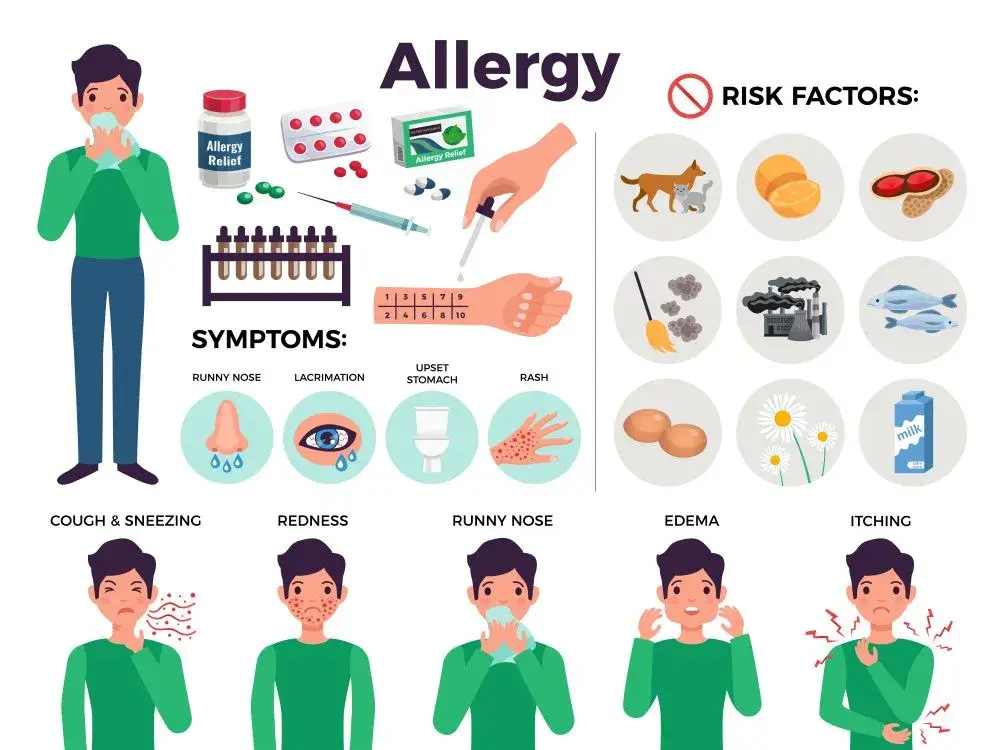Wheat allergy overview:
What is a wheat allergies?
- Wheat allergy remains one of the most prevalent food allergies. Eating or inhaling wheat triggers an exaggerated response from your immune system. While harmless to many it is perceived by those with allergies that wheat is a harmful invader like bacteria and viruses
Table of Contents
Possible Severity and Reaction Signs:
- Wheat allergies can pose a serious risk, with symptoms such as a swollen throat requiring immediate medical attention, including calling 911 and going to the nearest ER.
Demographics affected:
- Anyone can be allergic to wheat, and a family history of allergies can increase sensitivity.
Diffusion:
- Studies show that between 0.2% and 1.3% of the global population is allergic to wheat, and about 0.4% of children in the U.S. are affected.
Effects on the body:
- Wheat allergy triggers an allergic reaction, which manifests primarily in two ways.
1.Immunoglobulin E mediated response:
- Wheat consumption rapidly produces immunoglobulin E (IgE) antibodies in the body, causing immediate reactions. These reactions, including anaphylaxis, can occur minutes or up to four hours later, causing severe allergic reactions.
2. Non-immunoglobulin E mediated reaction:
- These reactions involve the immune system but not IgE antibodies. They appear more slowly and take up to 48 hours to develop. Symptoms include conditions such as eosinophilic esophagitis (EoE) or eosinophilic gastritis (EG), which cause inflammation of the esophagus or stomach lining respectively.
Wheat allergy symptoms causes:
Wheat Allergies Symptoms:
- Wheat allergy symptoms range from mild to severe and can include hives, burning sensation, stomach discomfort, nausea, vomiting, nasal congestion, wheezing, headache, wheezing, and anaphylaxis The severity of symptoms varies between individuals.
Anaphylaxis symptoms:
- Symptoms of severe anaphylaxis requiring immediate medical attention include shortness of breath, difficulty swallowing, chest tightness, feeling of impending doom, low blood pressure, increased heart rate, shock, weakness, lightheadedness, hives, swelling, wheezing, coughing and abdominal pain There are , nausea, and vomiting.
Onset of symptoms:
- The time of onset of symptoms varies depending on the severity of the allergy, ranging from minutes to 48 hours after wheat consumption.
Causes of Wheat Allergy:
- Proteins found in wheat trigger an exaggerated response from the immune system. Four specific wheat proteins—albumin, gliadin, globulin, and gluten—can cause allergic reactions.
Development of Wheat Allergy:
- Allergic reactions, IgE-mediated or non-IgE-mediated, seem to occur suddenly or gradually over time. IgE-mediated reactions can develop in infants, whereas non-IgE-mediated reactions can develop gradually until diagnosis.
Infectious Nature:
- Wheat allergies are not contagious; It cannot be transmitted from one person to another.

Wheat allergy diagnosis and testing:
Diagnostic Procedure:
- An allergist helps diagnose wheat allergies, especially those associated with IgE-mediated reactions. Diagnosis is evaluation and testing, considering factors such as family history, existing allergies, symptoms, medication use, onset of symptoms and dietary habits
Diagnostic Test:
- 1. Skin prick (scratch) test:
- Small amounts of wheat protein can be used as lancets or liquid drops on clean skin. This typically occurs on the forearm or upper back.
- Reactions, appear within 15 minutes and manifest as raised, pale discs resembling insect bites. An allergist gauges the reaction by measuring their size.
- 2. Blood (IgE) test:
- A lab draws a blood sample from your arm and adds wheat protein to measure IgE antibody levels.
- Results may take approximately one week to process.
- 3. Graded Verbal Challenge:
- If skin or blood tests yield inconclusive results, a graded oral challenge may be recommended.
- Conducted in an allergist’s office, it involves consuming small amounts of wheat, when any reaction is observed. The amount can be gradually increased to assess the body’s response.
- Generally, this is reserved for individuals at low to moderate risk of a severe allergic reaction and can last up to four hours.
- Based on symptoms and risk assessment, these tests help allergists make an accurate diagnosis of wheat allergy.
Management and treatment of wheat allergy:
Wheat allergy permanent removal:
- Wheat allergy cannot be prevented, although about 66% of children eventually grow out of it. Allergy management primarily includes avoidance, as mandated by U.S. labeling law that requires wheat to be listed on packaged food ingredients
Avoidance Considerations:
- Aside from food, certain non-food items such as Play-Doh®, cosmetics and toiletries can contain wheat. Manufacturers of non-food items are not required to label wheat content, so verifying ingredients through the manufacturer’s website or customer service is essential. Look for labels indicating shared equipment during construction (“built on shared equipment with wheat”).
Food and Drinks to Avoid:
- Many items contain wheat or its proteins, including baked goods, bread, cereals, couscous, hot dogs, malted beverages, pasta, pizza dough, seitan, wheat beer, and various wheat flours.
Remedies for wheat allergies:
- Mild to moderate allergies: Antihistamines or corticosteroid medications may be prescribed by health care providers to alleviate symptoms.
- Severe allergies: Epinephrine injectors (EpiPen®, Adrenaclick®, Auvi-Q®, and SYMJEPI®) are recommended. These injectors, usually the size of a large marker, quickly reverse the symptoms of anaphylaxis. It is advised to always carry two injectors for immediate use in case of accidental wheat consumption.
Epinephrine Injection Side Effects:
- Possible side effects of epinephrine injections include anxiety, dizziness, dry mouth, headache, increased sweating, nausea, and rapid palpitations but in an allergic reaction, epinephrine usually provides immediate relief.
Start of relief:
- Antihistamine: Usually begins to work 30 minutes after ingestion, with peak effectiveness in the first few hours.
- Corticosteroids: usually start working within an hour.
- Epinephrine Injection: Provides immediate relief upon administration.
Wheat allergy prevention:
Avoidance as a preventive measure:
- Prevention of wheat allergic reaction mainly involves strict avoidance of wheat ingredients in food and non-food products. It’s important to check ingredient labels on packaged foods, and when you’re unsure about a product’s wheat content, avoid it until you get confirmation from the manufacturer
Outlook / Forecast:
Living with a wheat allergy:
- Wheat allergy management poses challenges as symptoms can vary in severity and unpredictability. However, with vigilance, a full life can be lived. Health care providers can provide guidance on resources, support groups, and dieticians to help with daily eating.
Age and Allergy Flexibility:
- Children are more likely to have wheat allergies than adults, but approximately 80% of people outgrow these allergies over the age of 16 years.
lives with:
Consultation with Health Care Providers:
- If you continue to experience wheat allergy symptoms or notice the onset of symptoms after consuming wheat, seek medical advice.
Emergency Care:
- In the event of signs of anaphylaxis, immediate ER attention or calling 911 is required.
Questions for Health Care Providers:
– Wheat allergy diagnosis confirmed
- Determination of the severity of the allergy
– Recommendations for medications
- Understand the full range of side effects of prescribed medications
- Inquiring about support groups available for individuals or parents with wheat allergies
- Get recommendations from a qualified dietitian to manage allergy-related dietary needs.
Conclusion:
- Understanding wheat allergy involves recognizing the distinct nature of wheat and gluten from other conditions. Wheat allergy triggers immune system responses, causing a variety of symptoms ranging from mild to severe, and the best way to manage it is to strictly avoid products containing wheat Now terms like “gluten allergy” are misnomer; An actual condition that refers to damage to the immune system due to gluten intake is celiac disease, which affects the small intestine.
- It is important to distinguish between wheat allergy, gluten intolerance and celiac disease. Wheat allergy involves immune responses, gluten intolerance affects digestion, and celiac disease specifically targets the small intestine in response to gluten intake
- Careful monitoring for wheat allergies, avoiding potential exposure sources, consulting with health care providers, adhering to prescribed treatments or medications can significantly improve their quality of life plus identifying differences in these wheat-related conditions accurate diagnosis, proper management and informed lifestyle choices It helps to do.

Additional FAQs:
Q. Wheat Allergies vs. Gluten Allergies?
A. – Wheat allergies are different from gluten allergies; In reality, gluten is not an allergy.
– Actually this is celiac disease. This is often called a “gluten allergy.” In this condition, the immune system damages the small intestine after consuming gluten, a protein from wheat, barley, and rye.
Q. Wheat Allergy vs. Gluten Intolerance?
A. – Wheat allergy triggers an overreaction of the immune system when wheat is consumed.
– Gluten intolerance or non-celiac gluten sensitivity affects the digestive system. The body struggles to digest gluten, causing symptoms such as fatigue, nausea, or bloating.
Q. Wheat Allergy vs. Celiac Disease?
A. – Despite their similarities, wheat allergy and celiac disease are distinct.
– In wheat allergy, the immune system reacts with IgE or non-IgE reactions to wheat proteins.
– Celiac disease specifically targets gluten, which is found in wheat and other grains. The immune system response damages the lining of the small intestine, causing inflammation and impaired nutrient absorption, leading to malnutrition regardless of food intake.


